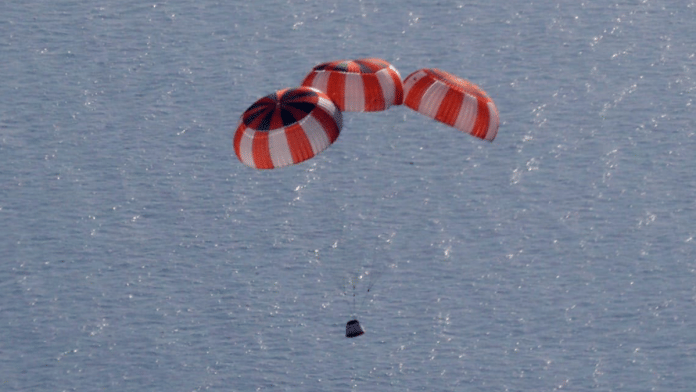New Delhi: The Indian Space Research Organisation (ISRO) has successfully conducted its first Integrated Air Drop Test (IADT-01), marking a key milestone in the preparation for India’s ambitious Gaganyaan Mission.
According to ISRO, the successful trial was a collaborative effort involving multiple defence and research organisations, including the Indian Air Force, Defence Research and Development Organisation (DRDO), Indian Navy, and Indian Coast Guard.
In a post on X, ISRO wrote, “ISRO successfully accomplishes first Integrated Air Drop Test (IADT-01) for end-to-end demonstration of parachute-based deceleration system for Gaganyaan missions. This test is a joint effort of ISRO, Indian Air Force, DRDO, Indian Navy and Indian Coast Guard.”
Earlier, Union Minister of State for Science and Technology Dr Jitendra Singh on Wednesday said that development and ground testing of the Human Rated Launch Vehicle (HLVM3) of India’s first human spaceflight programme Gaganyaan have already been completed.
“Orbital Module: The Propulsion systems for Crew Module and Service Module have been developed and tested. ECLSS engineering model realised. Crew Escape System (CES): 5 types of motors developed and static tested. Infrastructure established: Orbital Module Preparation Facility, Gaganyaan Control Centre, Gaganyaan Control facility, Crew training facility, Second Launch pad modifications,” Singh said in a written reply in the Lok Sabha.
“Precursor Missions: A Test Vehicle developed for validating CES and flight tested in TV-D1. Activities are in progress for TV-D2 and IADT-01. Flight Operations and Communication Network: Ground network configuration finalised. IDRSS-1 feeder stations and terrestrial links established. Crew Recovery Operations: Recovery assets finalised. Recovery Plan worked out. First Uncrewed Mission (G1): C32-G stage and CES motors realised. HS200 Motors and CES Fore end up to Crew Module Jettisoning Motor stacked. Crew Module and Service module structure realised. Crew Module Phase-1 checks completed,” he added.
The human spaceflight programme is aimed at fulfilling aspirations of an established spacefaring nation. The technological and manufacturing capabilities towards the goal of ‘Viksit Bharat’ will hinge on a transformative shift in the national research and technology development landscape.
He said that after proving the basic capabilities for human space activities under the Gaganyaan Programme, the next logical step is to initiate the development activities for a human habitat or a space station in low Earth orbit to enable longer human space missions. In this regard, the long-term vision of the Indian Human Space Programme includes the Bharatiya Antariksha Station (BAS) by 2035 and the Indian Moon Landing by 2040.
Highlighting the development of India’s own space station, Singh said that plans for establishing five modules of the Bharatiya Antariksha Station (BAS) by 2035, towards which approval for the development of the 1st module of BAS has been obtained.
As per the vision envisaged by the Government of India to land an Indian on the moon by 2040, the mission aspects, configuration of the launch vehicle and orbital module systems have been taken up. Training modules, including incremental training for the ongoing Gaganyaan programme and the proposed landing of an Indian on the Moon, are in line with the requirements of mission timelines, the MoS added.
This report is auto-generated from ANI news service. ThePrint holds no responsibility for its content.
Also Read: India has reason to be worried about Sri Lanka’s left turn, despite Dissanayake’s assurances




